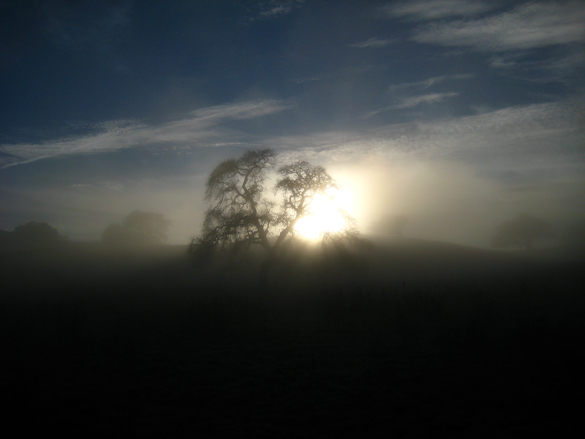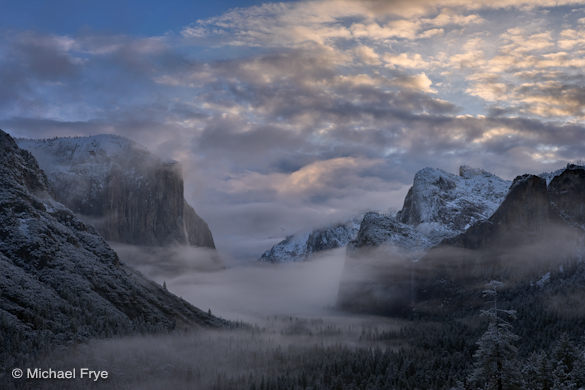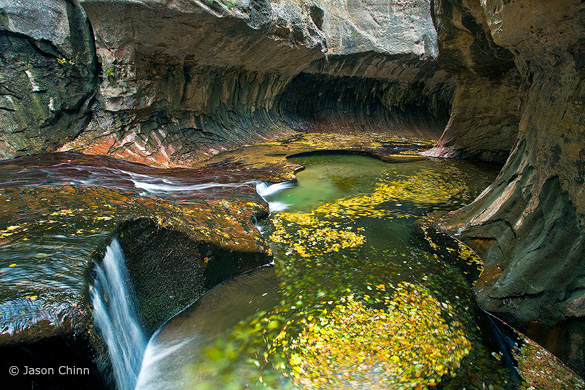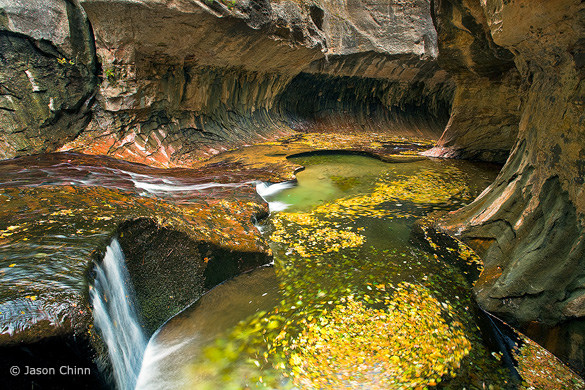by Michael Frye | Feb 10, 2010 | Critiques
The image I chose for the first critique in this series was made with a 4 x 5 view camera; this one was captured with a Canon Powershot SD1000—a point-and-shoot. But great photos can be made with any equipment, whether a 4 x 5, digital SLR, point-and-shoot, or pinhole camera. Vision is always more important than equipment.
Joe Navratil captured a great moment here, with the sun breaking through fog and silhouetting stately oaks. There’s a wonderful, optimistic mood to the photograph. The composition is pretty simple, and simplicity is always a good thing. One problem is that the main focal points—the sun and the largest tree—are centered. Now I’m not a stickler for the rule of thirds, or any rule for that matter. As Edward Weston said, “To consult the rules of composition before making a picture is a little like consulting the law of gravitation before going for a walk.” But the rule of thirds reminds us that photographs are usually more interesting if you place the main subject off-center—like a third of the way from the left or right edge of the frame. And I think that applies here: this image would be more dynamic if the main tree wasn’t centered.
Of course centered subjects are a common problem with point-and-shoot cameras, as putting the main subject off-center might cause the autofocus to latch onto the wrong thing. But you can always press the shutter button halfway to lock the focus (and usually the exposure too) on your subject, then, while holding the button down, recompose the picture and press the button all the way.
A more fundamental principle than the rule of thirds is simplicity. The best compositions contain only the essentials of the scene or subject, and nothing extra. Or, to quote Weston again, “To compose a subject well means no more than to see and present it in the strongest manner possible.” To me there’s too much empty space in this photograph—too much sky at the top, and too much dark foreground at the bottom. The image would have more impact if the most interesting areas, like the sun and that central tree, filled up more of the frame.
To illustrate what I’m talking about, I’ve cropped this photo two different ways. In the first version (Crop A) I’ve trimmed the image into a long, somewhat panoramic shape. This gets the main subject out of the center, and emphasizes the two longest lines—the horizon and the clouds. This framing also adds rhythm and repetition by giving more visual weight to the flanking trees, which echo the shape of the largest oak. The second version (Crop B) is tighter, more square, and fills the frame with the sun and that central tree. (more…)
by Michael Frye | Feb 9, 2010 | Light and Weather
Sunrise from Tunnel View, Sunday morning
In my last post I wished for the storm to clear right around sunset on Sunday. It didn’t quite work out that way—it cleared at sunrise instead. My private workshop student and I photographed a beautiful sunrise from Tunnel View, then moved to Cathedral Beach and Swinging Bridge. I always hope for mist, as it adds so much mystery and mood to photographs of Yosemite Valley. Sunday we had almost too much mist; massive cliffs like El Capitan were completely obscured for long stretches of time. But I’m not complaining! It was a great morning.
But where were all the photographers? We saw only a few other tripods all morning—and it was a weekend. Maybe they’re all waiting to come next week for Horsetail Fall.
by Michael Frye | Feb 5, 2010 | Yosemite Photo Conditions
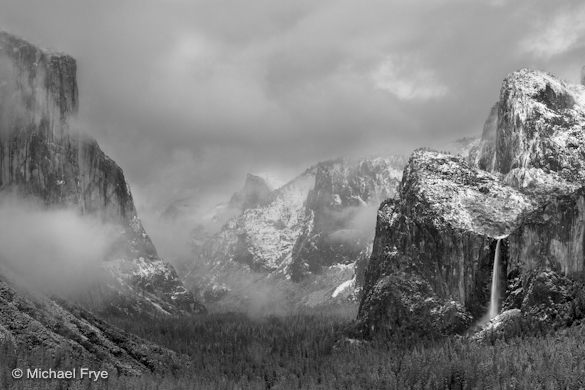
Clearing storm, Yosemite Valley
It’s been a strange winter. In an El Niño year like this we would expect to see a lot of rain and snow. But so far it’s been pretty dry, except for that one week in January when it snowed almost nonstop and all those trees fell in Yosemite Valley. It’s been mostly dry since then, but now it looks as if we might be getting into the wet pattern again. A storm arrived last night, and another one is expected tomorrow, with still more precipitation due on Tuesday and again Saturday.
As always, storms can provide great photo opportunities. It looks like the second system will dissipate sometime Sunday, so we could see some nice clearing storm conditions then. But it’s always hard to predict when these events might happen, and timing is critical. It’s ideal if the storm breaks up just before sunrise or just before sunset, but that’s rare. Often they end during the night. If that happens the next morning will frequently dawn clear, but with no mist — and it’s that mist that really makes things interesing.
Let’s hope for a classic Yosemite clearing storm on Sunday, maybe right around sunset…
by Michael Frye | Feb 3, 2010 | Critiques
“Subway 1” by Jason Chinn, original version
Thanks to all of you who continue to submit photographs for this critique. The Flickr pool keeps growing, and many more outstanding images have been added to the collection.
This week’s photo is by Jason Chinn from the Subway in Zion National Park. I chose it because it’s a beautiful photograph, with many lessons to impart, and also because the Subway is a special place to me. My wife Claudia and I hiked to the Subway back in 1988 when hardly anyone knew about it. Four miles of thrashing through brush and sloshing up the stream led us to this unique and beautiful place—a slot canyon that widens at the bottom into a tube (hence the name). I still have a couple of 35 mm slides from that day.
I like many things about this image, but let’s start with what’s not there. In his comments on Flickr Jason says that this was made on a cloudy day, and he was disappointed that he didn’t find the “Subway glow.” (Here’s one example of this, or go to Flickr and do a search with the words “Subway” and “Zion.”) Personally, I don’t miss that glow in this photograph. The swirling yellow leaves in the water make this image more interesting than most of the other Subway renditions I’ve seen, and the “glow” might have been just be a distraction here. (more…)
by Michael Frye | Feb 3, 2010 | Critiques
“Subway 1” by Jason Chinn, original version
Thanks to all of you who continue to submit photographs for this critique. The Flickr pool keeps growing, and many more outstanding images have been added to the collection.
This week’s photo is by Jason Chinn from the Subway in Zion National Park. I chose it because it’s a beautiful photograph, with many lessons to impart, and also because the Subway is a special place to me. My wife Claudia and I hiked to the Subway back in 1988 when hardly anyone knew about it. Four miles of thrashing through brush and sloshing up the stream led us to this unique and beautiful place—a slot canyon that widens at the bottom into a tube (hence the name). I still have a couple of 35 mm slides from that day.
I like many things about this image, but let’s start with what’s not there. In his comments on Flickr Jason says that this was made on a cloudy day, and he was disappointed that he didn’t find the “Subway glow.” (Here’s one example of this, or go to Flickr and do a search with the words “Subway” and “Zion.”) Personally, I don’t miss that glow in this photograph. The swirling yellow leaves in the water make this image more interesting than most of the other Subway renditions I’ve seen, and the “glow” might have been just be a distraction here.
Jason’s photograph has an appealing color palette, with yellows, rusty oranges, and greens. The composition also has a nice rhythm and flow; the stream coming in from the left leads your eye to the yellow leaves, and then to the tube of the Subway, plus there are many circles and curved lines that echo each other throughout the frame. The swirling leaves add a nice sense of movement.
I appreciate the fact that Jason didn’t try to pump up the color too much. I see many over-saturated, over-manipulated images on Flickr and elsewhere, but here I think the saturation seems just about right, and the photograph looks natural.
One thing I noticed is that the color balance, or white balance, seems a bit too blue. There’s a bluish tint to the water in the lower-left corner, as well as a hint of blue in the rocks near the top of the frame. Also, the bright rocks at the top-center of the photo pull my eye away from more interesting things in the middle of the picture. To a lesser extent this is also true of the bright rocks and water at the left edge. In this next version (Version B) I’ve warmed up the color balance and darkened the top and left sides of the image. (I did this in Lightroom, but you could easily do the same thing in Photoshop.) To me the result seems more coherent:
Version B, with warmer color balance and top and left edges darkened
The top and bottom of the frame still bother me though. The bright rock above the Subway at the top-center still grabs attention, and the image needs more room at the bottom, as the base of the little waterfall in the lower-left corner is cut off, and I’d like to see more of that circle of swirling leaves along the bottom edge. A wider lens would’ve helped, but looking at the EXIF data tells me that this was made with a 17 mm lens, which was probably as wide as Jason could go. Still, just pointing the camera down slightly would have lessened the space devoted to the distracting rock at the top, and shown more of the waterfall and circle of leaves at the bottom. I wonder if it would also have been possible to take a step back. Given what we have to work with here, I’ve cropped this image to eliminate some of the rock at the top of the frame (Version C). I think this works a little better, but I’m not sure. What do you think? And while you’re at it, what do you think of the other changes I made?
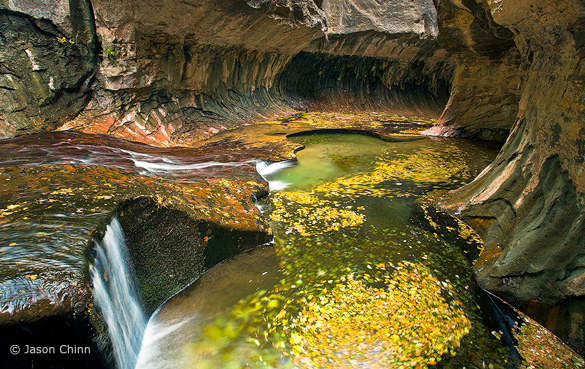
Version C, with the top edge cropped
Jason says that he used a polarizing filter to cut some of the reflections on the rocks and slow down the shutter speed, allowing him to blur the motion of the leaves (the polarizer cuts two stops of light, so acts like a neutral-density filter). The shutter speed was 2 seconds at f/14 and 100 ISO. A slower shutter speed would have added more motion and accentuated the swirling effect in the leaves. This could have been done by stopping down the aperture to f/22 and lowering the ISO to 50, cutting 2 1/3 stops of light and allowing a shutter speed of 10 seconds.
Despite my nitpicks I think this is a very nice photograph. In landscape photography we often set out with an idea in mind, but frequently the light and weather don’t cooperate. Rather than bemoan what’s not there, look around and ask yourself what is there. What’s special, unique, and interesting about this particular place at this particular time? Jason did just that. He was hoping to see the Subway “glow,” but clouds prevented that, so he looked around, found these pools filled with yellow leaves, and made them the centerpiece of his composition. He may have been disappointed, but personally I like this result better.
We often edit our own images with these preconceived ideas in mind. After spending time and energy to bring a concept to life, it’s easy to believe that the result is better than it is. On the other hand, we’re likely to overlook a photograph that’s didn’t match our expectations. Time and distance help. Days, weeks, or months later we’re better at judging our images objectively.
Thank you Jason for sharing your photograph! You can see more of his work on Flickr.
If you’d like your photographs considered for future critiques, just upload them to the Flickr group I created for this purpose. If you’re not a Flickr member yet, joining is free and easy. You’ll have to read and accept the rules for the group before adding images, and please, no more than five photos per person per week. I’ll post the next critique on February 9th or 10th. Thanks for participating!

